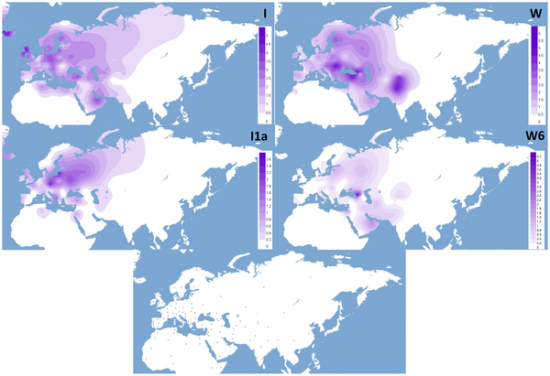University of Huddersfield
Source - http://www.eurekalert.org/pub_releases/2013-08/uoh-shf081213.php

Spatial frequency distribution of haplogroups I and W and the sub-clades I1a and W6. Note that different frequency scales (%) were used in the maps. The dots in the lower map indicate the geographic location of the population samples included in the survey (Table S3 in File S1). doi:10.1371/journal.pone.0070492.g002
Humans originated in Africa. But what route did they take as they began to disperse around the world 60,000 years ago? A new professor at the University of Huddersfield has played a key role in finding the answer to one of the most fundamental questions in the history of mankind.
Professor Richards, who moved to Huddersfield from the University of Leeds, is a pioneer in the field -- one of just two professors of archaeogenetics in the world. He uses DNA evidence to study human origins, comparing data from modern samples across the world and occasionally to that which can be obtained from ancient sources such as skeletal remains and fossilised teeth. It leads to a vivid picture of the migration patterns of humankind and the origins of civilisation.
The article in PLoS ONE provides new evidence to indicate that early humans migrated into Europe after the Last Glacial Maximum but before Neolithic times, giving us a clearer picture of how early humans were developing at this time.
Professor Richards spent ten years as a researcher at Oxford University before first coming to the University of Huddersfield for a lecturing post in 2000. He then moved to Leeds, where he was awarded his professorship, before returning to Huddersfield, where he is currently equipping archaeogenetics research facilities. He is joined by his colleagues Dr Maria Pala, Dr Paul Brotherton and Dr Martin Carr.
One laboratory is being set up for the main molecular biology work and a separate lab built for the analysis of ancient DNA. There must be no risk of the evidence being cross-contaminated. "It's like forensics but even more so. It has to be in another building, segregated from the rest of the work we do here," said Professor Richards.
Postgraduates will be recruited to study archaeogenetics at Huddersfield -- to join an expanding field of research that aims to establish the history of the dispersal of human populations around the world.

Phylogenetic tree of haplogroups N1a1b and W.
This schematic representation is based on 196 N1a1b and 223 W mitogenomes whose phylogenetic relationships are illustrated in detail in Figure S1 and Figure S2. The phylogenetic connections between N1a1b and W are also shown. Approximate ages can be inferred from the scale. For haplogroups N1a1b and W, they correspond to the ML ages in Table 1 while previously reported ML ages were employed for nodes N, N1 and N2 [3]. doi:10.1371/journal.pone.0070492.g001